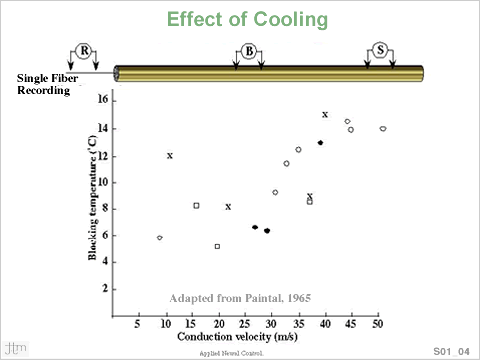
In clinical studies, nerve conduction velocity is considered
to decrease by roughly 2 m/s per °C of cooling. Decrease
in nerve conduction velocity have been observed following cold
water immersion [1]. A positive
correlation has been observed between decrease in surface temperature
and decrease in nerve conduction
velocity of 1.7 m/sec for every 1°C decrease in surface temperature [2].
There have been conflicting results reported on the blocking effect of
cooling. Taken together, some of the data suggested that smaller diameter
axons were blocked at lower temperatures than larger axons subjected to
the same temperature. During cooling, the latencies increase slowly and
then rapidly before conduction was blocked. The differential effect of
axon diameter that was observed was due to the effect of the latencies
on the Compound Action Potential. Lowering of conduction velocities destroyed
components of the CAP leading to the impression that block was occurring.
Single fiber recordings revealed that conduction velocities slowed before
block occurred and the blocking temperature was between 3∞C and
9∞C for all healthy fibers, higher if the nerves were stretched
or injured [3].
Lowering the temperature of a nerve might block conductions because gating ion
channels involves conformational changes in the protein and the rates at which
these conformational changes take place are voltage and temperature sensitive.
The Q10 for the rate constants are reported to be 2 to
4, meaning that the rate changes by a factor of 2 to 4 for each 10¾C change in
temperature [4]. So if
Delta T is -25¾C then Q.Delta T = (Q10)Delta T/10 = 0.06
or
about
16
times slower (assuming Q10=3).
[1.] Abramson DI, Chu LS, Tuck S Jr, Lee SW, Richardson
G, Levin M. (1966) Effect of tissue temperatures and
blood flow on motor nerve conduction velocity. JAMA.
198:1082-1088.
[2.] Halar EM, DeLisa JA, Brozovich FV. (1980) Nerve conduction velocity: relationship
of skin, subcutaneous and intramuscular temperatures. Arch Phys Med Rehabil.
61(5):199-203.
[3] Paintal, A.S. (1965) Block of conduction in mammalian nerve fibers by low
temperatures. J. Physiol. 180 (1) 1-19.
[4] Hille, B. (2001) Ion Channels of Excitable Membrane (3rd Edition). Sunderland,
Mass. Sinauer Associates, Inc.
|

